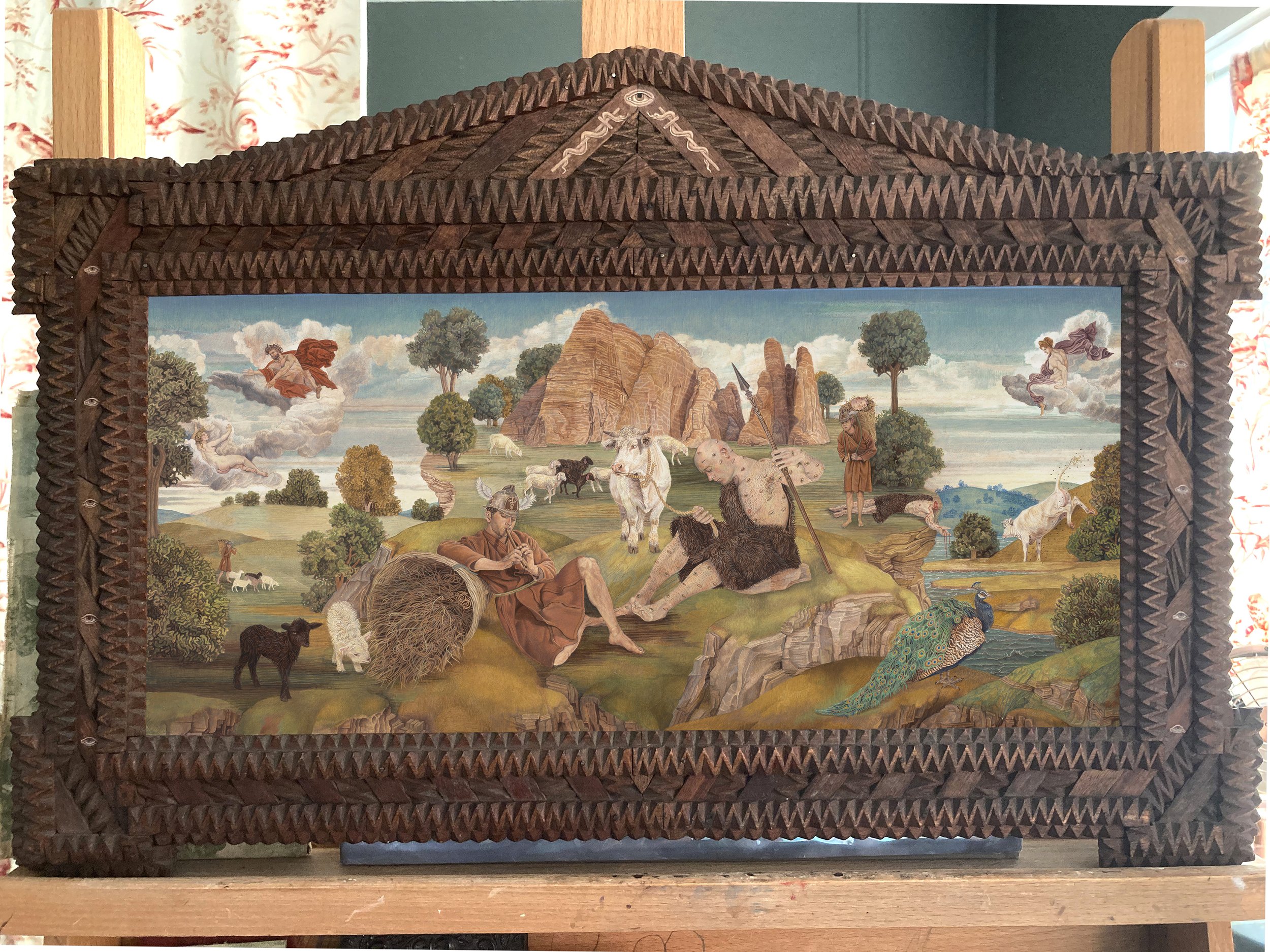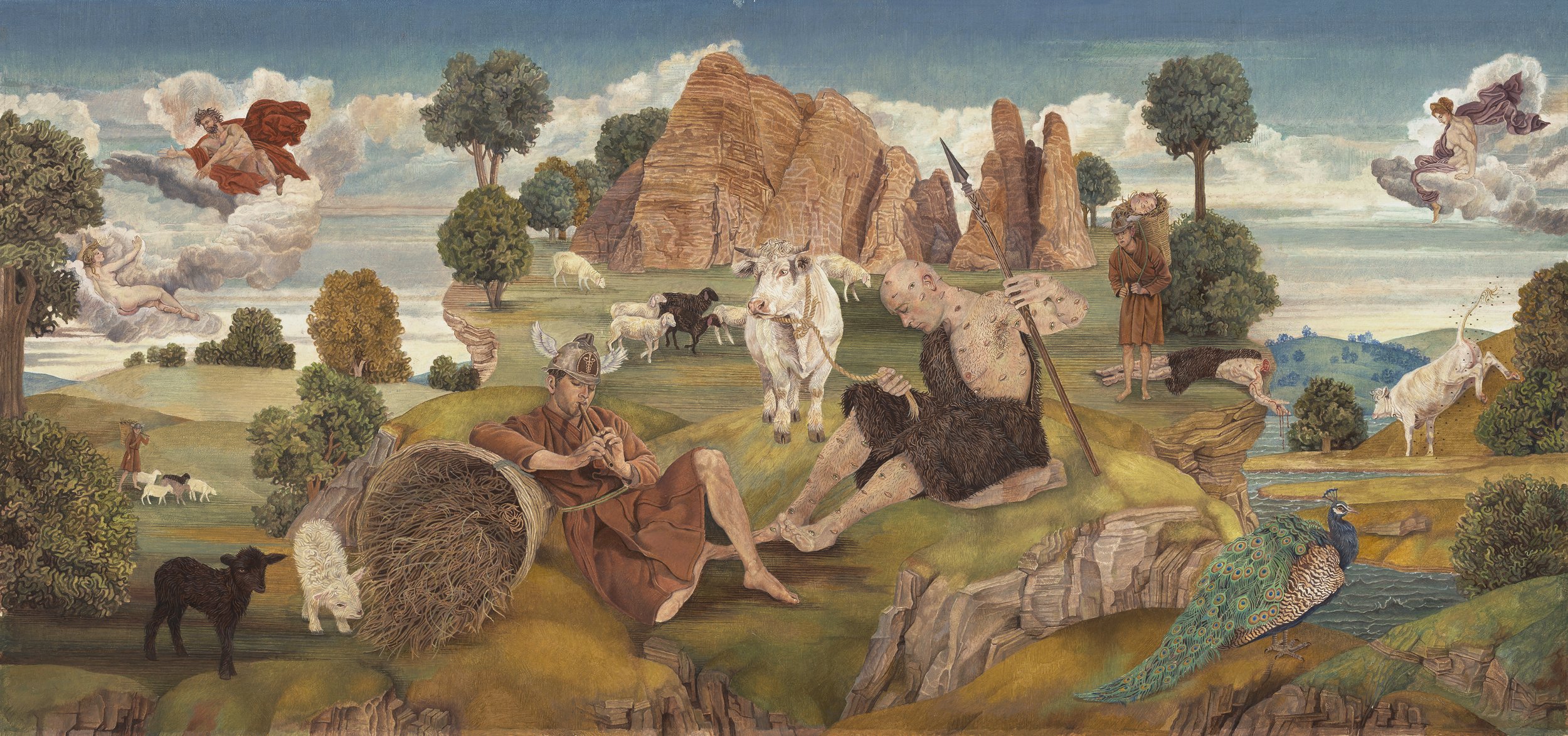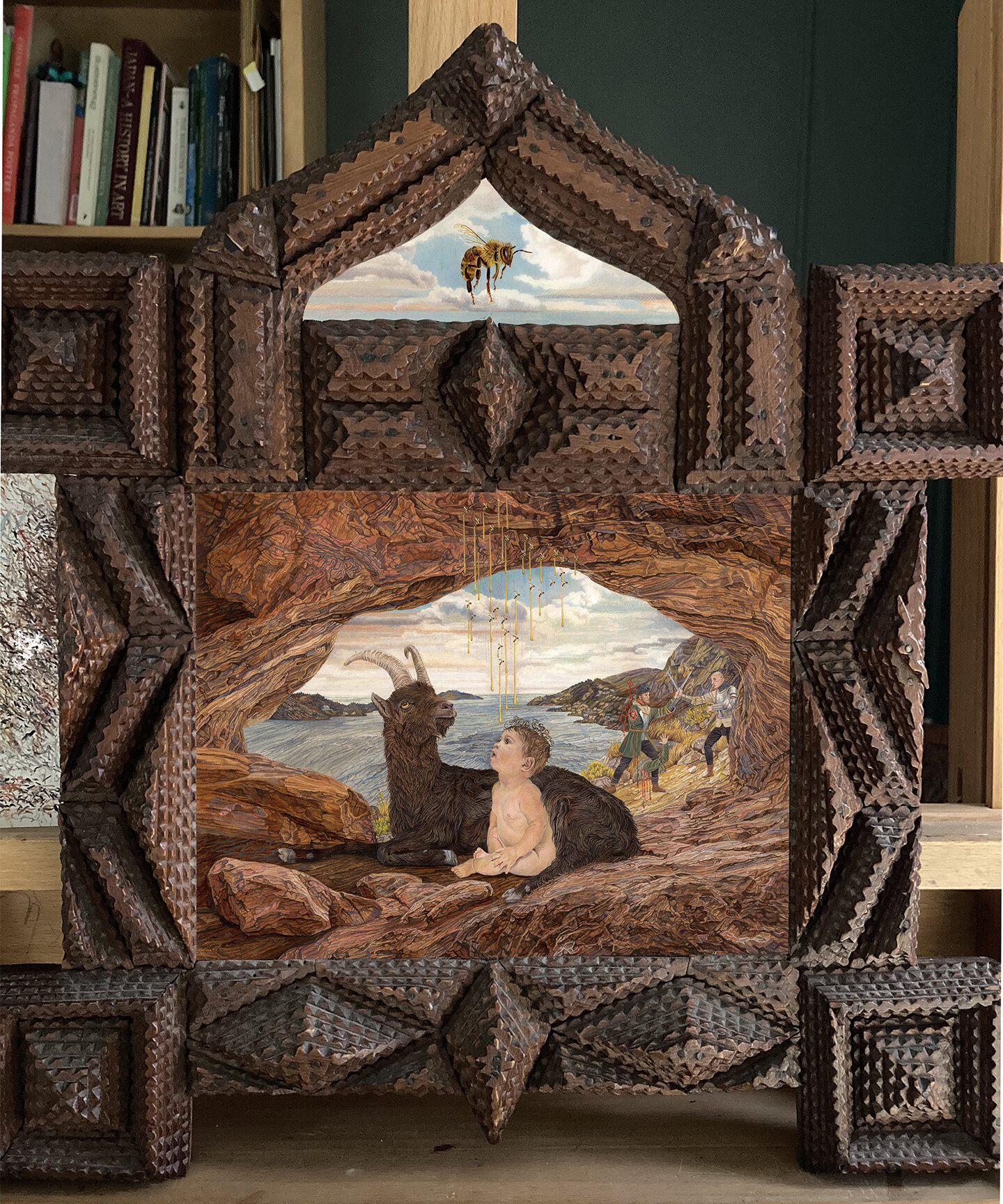Calydonian Boar & Company - 10 in x 13 in - Oil on Panel - 2023


Io, Argos & Hermes - 8.5 in x 17 in - Oil on Panel - 2022
Io was a priestess of the Goddess Hera in Argos, whose cult her father Inachus was supposed to have introduced to Argos. Zeus noticed Io, a mortal woman, and lusted after her. She initially rejected Zeus' advances, until her father threw her out of his house on the advice of oracles. Zeus’s jealous wife Hera then transformed Io into a heifer. Hera then sent Argos Panoptes, a giant who had 100 eyes, to watch Io and prevent Zeus from visiting her, and so Zeus sent Hermes disguised as a shepherd to distract and eventually slay Argos. According to Ovid, he did so by first lulling him to sleep by playing the panpipes and telling stories. Hermes then slays Argos, chops off his head and Zeus frees Io, still in the form of a heifer. Hera uses Argus' eyes to decorate her peacock's feathers to thank the giant for his help. In order to exact her revenge, Hera sent gadflies to sting Io continuously, driving her to wander the world without rest.
Zeus and Amalthea - 8in x 10in - Oil on panel - 2021


In Greek mythology Zeus' father was Cronus and his mother Rhea. Cronus had usurped control of the heavens from his father Ouranos and he was afraid his own children would treat him to the same fate. To pre-empt any takeover he swallowed all of his children. When Rhea gave birth to her sixth child Zeus she wrapped a stone in baby clothes and gave it to her husband to swallow instead of baby Zeus. She then secreted him away to a cave on Mt Dicte where he was suckled and cared for by the goat goddess Amalthea. The cave was populated by sacred bees which fed the infant god honey. Zeus eventually dethroned his father Kronos and became the new king of the gods. Likely due to this story, one of Zeus’s titles was Melissaios, or “bee-man”. Zeus later rewarded the bees for their assistance by making them bright gold in color, and strong enough to resist cold and winds.
Laelaps - 9in x 5in - Oil on panel - 2020

Pan & Syrinx - 9in x 5in - Oil on panel - 2019


This set of 4 paintings are some of my tiniest fully detailed works to date. The central 2 panels are 3in x 5in and the side panels are 1.5in x 5in. Pursued by the amorous god Pan, Syrinx ran to the water’s edge and asked for assistance from the river nymphs. In answer, she was transformed into hollow water reeds that made a haunting sound when the god's frustrated breath blew across them. Pan cut the reeds to fashion the first set of pan pipes, which were thenceforth known as syrinx.
Callisto & Arcas - 14in x 11in - Oil on panel - 2019


In Greek mythology, Callisto was a nymph who was one of the followers of Artemis. She had the misfortune of attracting the attention of Zeus who transformed himself into the figure of Artemis and seduced her in this disguise. She became pregnant and when this was eventually discovered, she was expelled from Artemis's group, after which a furious Hera (the wife of her seducer) transformed her into a bear. Later, just as she was about to be tragically killed by her own unwitting son when he was hunting, Zeus took pity on mother and son and set them among the stars as Ursa Major (the Great Bear). and Ursa Minor (little bear). She was the bear-mother of the Arcadians, through her son Arcas by Zeus. The tiny people/ constellations in the sky are about 1-1.5 in tall.
Theseus & the Minotaur - 12 in x 12in - Oil on panel. 2018


The Minotaur was the son of Pasiphae, wife of King Minos of Crete. Queen Pasiphae slept with a bull sent by Zeus, and gave birth to Minotaur, a creature half man – half bull. King Minos was embarrassed, but did not want to kill the Minotaur, so he hid the monster away in the depths of the castle. Androgeus, son of Minos, went to Athens to participate to the Panathenaic Games, but he was killed during the Marathon by the bull that impregnated his mother Pasiphae. Minos was infuriated, and demanded Aegeus the king of Athens to send seven men and women every year to the Minotaur to advert the plague caused by the death of Androgeus. The third year, Theseus, son of Aegeus decided to be one of the seven young men that would go to Crete, in order to kill the Minotaur and end the human sacrifices to the monster. King Aegeus tried to make him change his mind but Theseus was determined to slay the Minotaur. Minos let loose the Athenian enemies in a Labyrinth so that the Minotaur could hunt them down and eat them. The labyrinth was such a complicated construction of twisting alleyways and dead ends that no one could ever find the way out alive. Theseus announced to King Minos that he was going to kill the Monster, but Minos knew that even if he did manage to kill the Minotaur he would be able to find and slay him before he escaped. Theseus met Princess Ariadne, daughter of King Minos, who fell madly in love with him and decided to help Theseus. She gave him a thread and told him to unravel it as he journeyed through the unknown place, so that he would know the way out once he killed the monster. Theseus followed her suggestion and entered the labyrinth with the thread. Theseus managed to kill the Minotaur and save the Athenians, and with Ariadne’s thread he managed to retrace his steps and escape before Minos discovered the death of his son, the Minotaur. I read an account which suggested that there was no labyrinth discovered under the castle and that the Minotaur was actually set loose among the labyrinthine city streets, so I ran with that version.
Scylla & Charybdis - 10 in x 8in - Oil on panel. 2017


Scylla and Charybdis were situated on opposite sides of the Strait of Messina, between Sicily and the Italian mainland. Scylla is described as a six-headed sea monster and was rationalized as a rock formation on the Italian side of the strait. Charybdis was a turbulent whirlpool off the coast of Sicily. The two created a treacherous passage and were considered an unavoidable hazard to passing sailors. To avoid Charybdis meant that one had to pass nearer to Scylla and vice versa. According to Homer, Odysseus was forced to choose which monster to challenge while passing through the strait. Odysseus wisely chose to sacrifice a few sailors to Scylla rather than losing his entire ship and crew to Charybdis. The idiomatic expression “between a rock and a hard place” comes from this myth.
Persephone & Hades - 8.5in x 14in - 2017 - Oil on Panel


Persephone was born of the union of Zeus, king of all gods, and Demeter, the goddess of the harvest. She was wooed by gods, such as Hermes and Apollo, but Demeter rejected all their gifts and jealously hid her beautiful daughter away. Hades, the god of the underworld, was madly in love with Persephone. He spoke to Zeus who granted Hades the right to abduct Persephone without Demeter’s knowledge. Thus, when Persephone was out gathering flowers in a field, Hades surged through a cleft in the earth and drug her down to reign alongside him as princess of the underworld. Demeter desperately searched for her lost daughter all over the earth with Hecate's torches. Unable to find Persephone, she became so distraught that the crops of Greece withered and died in the absence of her ministrations. Eventually, Hades was forced to allow Persephone to spend half the year with her mother so that crops would be able to flourish during those months. The crops were dormant the other six months due to Demeter’s despair at being separated from her daughter. The changing of the seasons was rationalized by this myth.
Phineas & the Harpies - 10in x 11in - 2017 - Oil on Panel


Phineus was a human prophet and ruler of Thrace in the northeastern region of Greece. He was gifted by the gods with remarkable foresight. Zeus, the king of all the gods, became enraged when Phineus started prophesying too accurately and revealing divine truths to mere mortals. Zeus blinded Phineas and abandoned him on an island before a table which was continuously laid with delicious food and drink. Before Phineas could enjoy even a morsel, Zeus dispatched his Harpies, the spirits of short violent blasts of wind who took the form of bird-like women. The harpies saw to it that Phineus would never get to enjoy so much as a crumb of bread during this everlasting feast. Every time Phineus would sit down to eat, the harpies robbed him of his meal in some cruel fashion or another, cawing and shrieking all the while.
Aristaeus - 14in x 6in - 2016 - Oil on Panel



The minor god Aristaeus, son of Apollo, is often credited with being the first beekeeper. He was taught to tend bees by Mother Earth Gaia's nymphs. According to myth, Aristaeus fell madly in love with Eurydice, the wife of Orpheus. In her haste to escape Aristaeus's unwanted attention, Eurydice fled and accidentally stepped on a serpent that bit and killed her instantly. Eurydice’s nymphs chose to punish Aristaeus by destroying his beloved bees. It was decided Aristaeus must slaughter four bulls and four heifers as a sacrificial offering to appease the nymphs. Once the offering was fulfilled, the bees miraculously swarmed from the carcass of the slaughtered animals and Aristaeus was able to rebuild his hive and pass on his knowledge of beekeeping to humankind. The belief that bees were born from the carcasses of dead animals persisted for centuries because of this myth. There is a panel painted by Jacopo del Sellaio of the moments of the story prior to this in which Eurydice trods on the snake as Aristaeus pursues her which was part of a series of panels on a sarcophogus which tells the whole story. The final panel/ piece in the series is missing. I imagined here what that missing panel may look like if I had a chance to recreate it as a member of his workshop.
